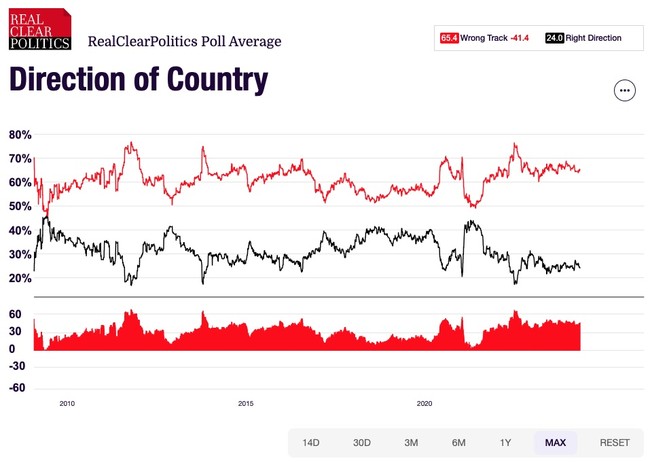Call this the Morrissey Chaos Theory: Chaos damages the party in power. It happened in 2020, which I predicted in February 2020, a month before the COVID-19 pandemic hit the US and started a cascading series of chaotic policies and events. The theoretical crisis turned out to be different — I used an economic crisis as a model — but the sequence of events proved me correct:
[Amy] Klobuchar’s appeal in a campaign against Trump would be a return to status quo ante normalcy. If voters become anxiety-ridden about the present state of affairs, they won’t want a revolution in the Bernie Sanders sense, but a nostalgic turn toward a pre-Trump technocracy to rescue the country from chaos. Under those circumstances, Trump’s chaos-agent qualities would play against him, and Democrats would be well advised to nominate an establishment figure who can soothe panic.
That only works if the status quo ante is far more appealing than the status quo, however. And frankly, that kind of crisis suits Joe Biden better than Amy Klobuchar too, as Biden has the eight years of the Obama administration on his resumé while Klobuchar has no real executive experience to tout, in either the private or public sector. Absent an economic crisis, though, voters are much less likely to care about Trump’s comportment or his Twitter habits. If the good times are rolling and they expect them to keep going, then voters will not want a return to technocratic/bureaucratic governance.
Just a few weeks later, the US electorate got a yuuuge dose of anxiety, crisis, and chaos. Even that may have played for Trump had he been able to corral his impulses toward chaos and refrained from his usual pugilism and demagoguery. Instead, Trump ended up narrowly losing to Biden in an election drenched with unhappiness over the status quo, with voters expecting an end to the chaos by a return to pre-Trump ‘normalcy.”
instead, Americans went from the chaotic frying pan and into the runaway-inflationary fire. Chaos broke out in Kabul as Joe Biden abandoned 14,000 Americans while getting chased out of Afghanistan by the Taliban. Wars broke out in Ukraine and Israel, while Biden’s “Don’t Doctrine” turned out to be a sick joke. And now, college campuses and American cities are the settings for ongoing quasi-insurrections, with roads blocked and buildings seized by pro-Hamas activists attempting to promote a violent revolution.
Is it any surprise that voters have decided to abandon technocratic/bureaucratic governance in the midst of the chaos it has delivered? Even the New York Times recognizes the pattern in their latest battleground polls, where Donald Trump now leads in almost every state won by Joe Biden four years ago:
Donald J. Trump leads President Biden in five crucial battleground states, a new set of polls shows, as a yearning for change and discontent over the economy and the war in Gaza among young, Black and Hispanic voters threaten to unravel the president’s Democratic coalition.
The surveys by The New York Times, Siena College and The Philadelphia Inquirer found that Mr. Trump was ahead among registered voters in a head-to-head matchup against Mr. Biden in five of six key states: Michigan, Arizona, Nevada, Georgia and Pennsylvania. Mr. Biden led among registered voters in only one battleground state, Wisconsin.
That’s a curious distinction, since Trump edges Biden among likely voters. Among LVs, Trump leads in Arizona (+6), Georgia (+9), Nevada (+13), Pennsylvania (+3), and Wisconsin (+1). Trump only trails Biden in Michigan, and even then only by a single point. The latter three can be fairly considered virtual ties within the margins of error, but that’s not true of Arizona, Georgia, and Nevada. If Trump wins those states in November, Biden can only afford to lose three more Electoral College electors (see 270toWin) — and PA +3 looks like a big risk for Biden. A loss in any of the other three states would doom Biden, not to mention the risk of losing New Hampshire and possibly Virginia.
By the way, it’s not just the NYT/Siena series that suggests this outcome. RCP’s polling aggregation in these states make it clear that this is not an outlier:
Worth noting as well: Only in the latter two states has Biden led in any recent polling, and none outside the margin of error for those polls.
How can one explain this, especially with Trump already so well known and, er … complicated? Has Trump grown suddenly popular? Perhaps marginally, but the answer likely can be found in Joe Biden’s assessments by the electorate. Biden’s aggregate job approval is now worse than at any time after July 2022 as inflation raged; it’s now at 39.5%, with 56.6% disapproving.
But this graph of the “right/wrong direction” polling aggregation likely explains it better. Nearly two-thirds of Americans (65.4%) believe the country is going in the wrong direction with Biden at the helm:

The NYT sees this in its polling data, too:
The findings reveal widespread dissatisfaction with the state of the country and serious doubts about Mr. Biden’s ability to deliver major improvements to American life. A majority of voters still desire the return to normalcy promised by Mr. Biden in the last campaign, but voters in battleground states remain particularly anxious, unsettled and itching for change. Nearly 70 percent of voters say that the country’s political and economic systems need major changes — or even to be torn down entirely.
Only a sliver of Mr. Biden’s supporters — just 13 percent — believe that the president would bring major changes in his second term, while even many of those who dislike Mr. Trump grudgingly acknowledge that he would shake up an unsatisfying status quo.
Take a look again at the graph, especially at the big spike in dissatisfaction in 2020. Eight months prior to that, this measure had been relatively stable, and certainly narrower than it was during Barack Obama’s successful re-election campaign in 2012. The big negative surge for Trump came in July of 2020, at the peak of the street riots and the COVID lockdowns. By the time the election came around in November 2020, “wrong direction” had moderated to 61.2% — and Trump still narrowly lost.
By contrast, the “wrong direction” level hasn’t been lower than 60% since Biden’s Kabul Bug-Out, and it has been above the 61.2% level for 30 months. (The gap measure at the bottom gives us a good visualization of this.) We haven’t had this level of sustained dissatisfaction in the sixteen years that this graph covers. This isn’t a momentary dissatisfaction, in other words, but a chronic rejection of Biden and his policies.
Plenty can happen between now and November, but perhaps not enough for Biden. Since the chaos at home and abroad keep growing, we can expect opposition to Biden to do the same, which in this case benefits Trump regardless what people think of him. Voters will want a return to the status quo ante again, perhaps especially because Trump will be term-limited and can provide a short-term solution that will necessitate a reset in both parties for 2028.
Even if Biden can somehow get the campus chaos under control between now and the election, all of the rest of the unsettling developments will push voters to the alternative. Even those voters willing to talk to the New York Times … and that really speaks volumes.












